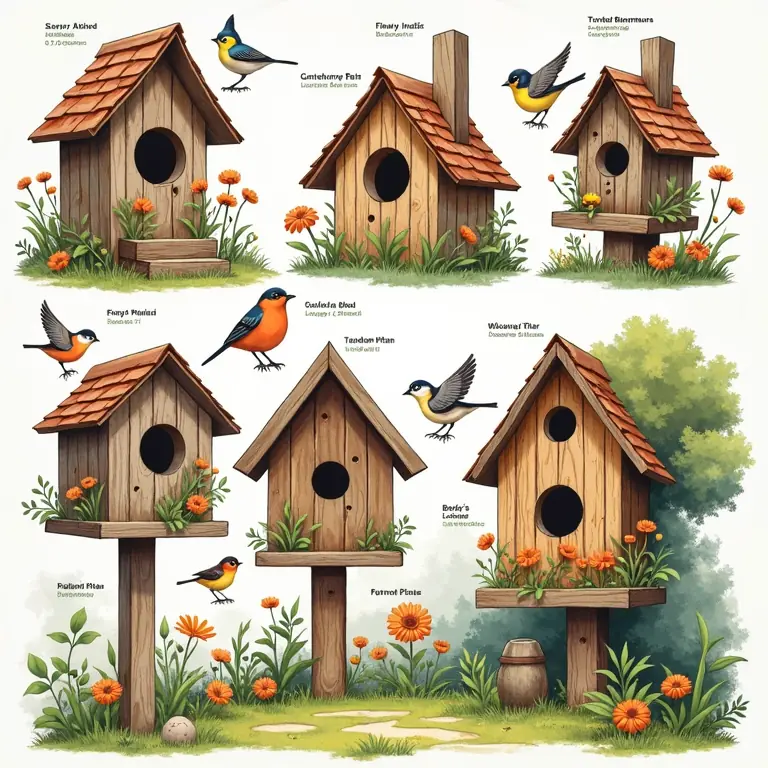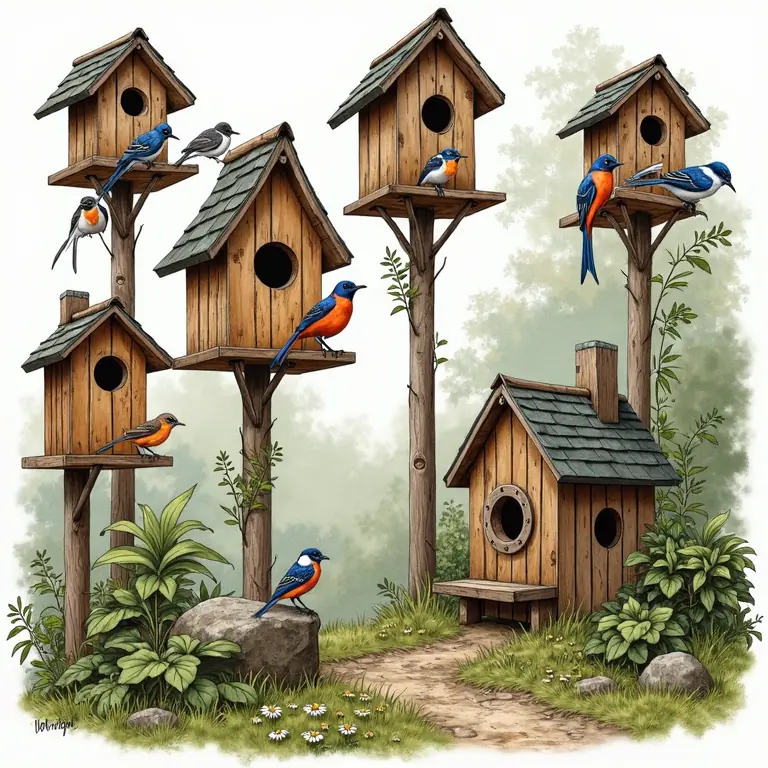Build a Better Birdhouse: A Friendly Guide to Attracting Specific Species
Birdhouses aren’t just charming garden decorations; they’re vital support for local bird populations, especially in areas where natural nesting sites are dwindling. But simply slapping up a birdhouse isn’t enough! To truly help our feathered friends, and enjoy the rewards of having them close by, we need to think like birds. This guide will walk you through everything you need to know about building and placing birdhouses to attract specific species, turning your garden into a haven for avian life. We’ll cover everything from materials and dimensions to placement and maintenance. Let’s get started!
Why Attracting Specific Species Matters
Different birds have different needs. A house suitable for a tiny wren won’t work for a larger bluebird, and a house placed in direct sunlight might be uncomfortable for a species that prefers shade. Understanding these preferences is key. Attracting specific species also allows you to contribute to local conservation efforts. Some bird populations are declining, and providing suitable nesting sites can make a real difference.
Understanding Birdhouse Basics
Materials: What to Use (and What to Avoid)
The best material for birdhouses is untreated, naturally durable wood like cedar, redwood, or cypress. These woods are weather-resistant and don’t require chemical treatments. Pine is acceptable, but it won’t last as long. Avoid pressure-treated wood, as the chemicals used in the treatment can be harmful to birds. Plywood can be used for some parts, but ensure it’s exterior-grade and well-sealed. Metal birdhouses can overheat in the sun, so they’re generally not recommended.
Essential Design Elements
- Ventilation: Crucial for keeping chicks cool in summer. Drill small ventilation holes near the top of the sides.
- Drainage: Prevents nests from becoming waterlogged. Drill small drainage holes in the floor.
- Rough Interior: Fledglings need to be able to climb out. Do NOT add perches inside or outside the house – they only help predators. Leave the interior wood rough, or score it with horizontal lines.
- Overhanging Roof: Protects the entrance from rain and sun.
- Easy Access for Cleaning: A hinged side or bottom makes cleaning much easier.
What to Avoid
- Perches: Attract predators.
- Bright Colors & Elaborate Decorations: Can deter birds and attract unwanted attention. Stick to natural colors.
- Chemical Treatments: Harmful to birds.
- Plastic Birdhouses: Can overheat and don’t provide adequate insulation.
Birdhouse Dimensions for Specific Species
Here’s a guide to the ideal dimensions for attracting different bird species. These are guidelines, and slight variations are okay, but aiming for these dimensions increases your chances of success. All dimensions are internal.
| Species | Floor Size (inches) | Height (inches) | Entrance Hole Diameter (inches) | Entrance Height Above Floor (inches) |
|---|---|---|---|---|
| House Wren | 4×4 | 6-8 | 1 1/8 | 4-6 |
| Carolina Wren | 6×6 | 8-10 | 1 1/4 | 6-8 |
| Eastern Bluebird | 5×5 | 8-10 | 1 1/2 | 6-8 |
| Tree Swallow | 5×5 | 6-8 | 1 3/4 | 4-6 |
| Purple Martin (Colony House) | 6×6 per compartment | 6-8 | 2 1/8 | 1-2 |
| Chickadee | 4×4 | 8-10 | 1 1/8 | 6-8 |
| Nuthatch | 4×4 | 8-10 | 1 1/4 | 6-8 |
Placement: Location, Location, Location
Where you place your birdhouse is just as important as the house itself. Here’s a breakdown of placement guidelines for different species:

- Bluebirds: Open areas with short grass, near perches like fences or trees. Face the entrance away from prevailing winds.
- Wrens: Brushy areas, gardens, or near shrubs. They prefer some cover.
- Swallows: Open areas near water sources. They’re aerial insectivores and benefit from nearby foraging grounds.
- Purple Martins: Open areas, 10-20 feet off the ground, at least 30 feet from trees. They prefer to be in colonies.
- Chickadees & Nuthatches: Wooded areas or near trees. They prefer some cover and shade.
General Guidelines:
- Height: Most birdhouses should be mounted 5-10 feet off the ground.
- Sunlight: Avoid placing birdhouses in direct, all-day sunlight. Partial shade is ideal.
- Predator Protection: Mount birdhouses on metal poles with predator guards to deter cats, raccoons, and snakes.
- Spacing: If you’re putting up multiple birdhouses, space them appropriately for the species. Bluebirds need more space than wrens.
Building Your Birdhouse: A Step-by-Step Guide (Bluebird House)
Let’s build a bluebird house! This is a relatively simple project that’s perfect for beginners.
Materials You’ll Need
- One 1” x 6” x 6’ cedar board (untreated)
- Screws (exterior grade)
- Wood glue (exterior grade)
- Drill
- Saw
- Measuring tape
- Sandpaper
Cutting List (Based on 5×5 floor, 8-10” height)
- Front: 6” wide x 9” long
- Back: 6” wide x 12” long (extends above for mounting)
- Sides (2): 6” wide x 7” long (angled at the top to meet the roof)
- Floor: 5” x 5”
- Roof (2): 8” wide x 6” long (creates overhang)
Instructions
- Cut the Wood: Using the cutting list, carefully cut all the pieces of wood.
- Drill Holes: Drill a 1 1/2” entrance hole in the front piece, 6-8” from the bottom. Drill ventilation holes near the top of the side pieces and drainage holes in the floor.
- Assemble the Sides: Attach the side pieces to the floor using wood glue and screws.
- Attach the Front: Attach the front piece to the assembled sides and floor, using glue and screws.
- Attach the Back: Attach the back piece, ensuring it extends above the sides for mounting.
- Attach the Roof: Attach the roof pieces, creating an overhang.
- Sand: Sand any rough edges.
Your bluebird house is now complete! Remember to mount it securely on a pole with a predator guard.
Maintenance: Keeping Your Birdhouses Clean and Safe
Regular maintenance is essential for keeping your birdhouses healthy and inviting. Here’s what you need to do:

- Cleaning: Clean out birdhouses at least once a year, after nesting season is over (usually in late summer or early fall). Remove old nesting material and debris.
- Repairs: Check for any damage to the birdhouse and make necessary repairs.
- Predator Control: Regularly inspect predator guards and ensure they are functioning properly.
- Insect Control: If you notice infestations of mites or other insects, you can lightly dust the inside of the birdhouse with diatomaceous earth.
Troubleshooting: Why Aren’t Birds Using My Birdhouse?
Sometimes, despite your best efforts, birds may not move into your birdhouse. Here are a few potential reasons and solutions:
- Wrong Location: Try moving the birdhouse to a more suitable location.
- Predators: Ensure adequate predator protection.
- Competition: Other birds may be competing for nesting sites.
- House is Too New: It can take time for birds to discover and accept a new birdhouse.
- Entrance Hole Size: The entrance hole may be too small or too large for the species you’re trying to attract.
Resources and Further Learning
Here are some helpful resources for learning more about birdhouses and attracting birds:
And if you’re interested in understanding animal behavior in general, you might enjoy this article about decoding your dog’s body language. Or perhaps you need help with another form of creative curation? Check out this guide to planning your perfect playlist. Finally, if you’re looking to simplify your life, you might appreciate this guide to the KonMari method.
Identifying Birds: A Crucial Skill
Knowing which birds are visiting your garden is key to providing the right kind of habitat. It’s not always easy, though! Sometimes, it’s harder than you think.
Building and placing birdhouses is a rewarding experience. By understanding the needs of different bird species, you can create a welcoming environment for them in your garden and contribute to their conservation. Happy birding!


Discussion about this post